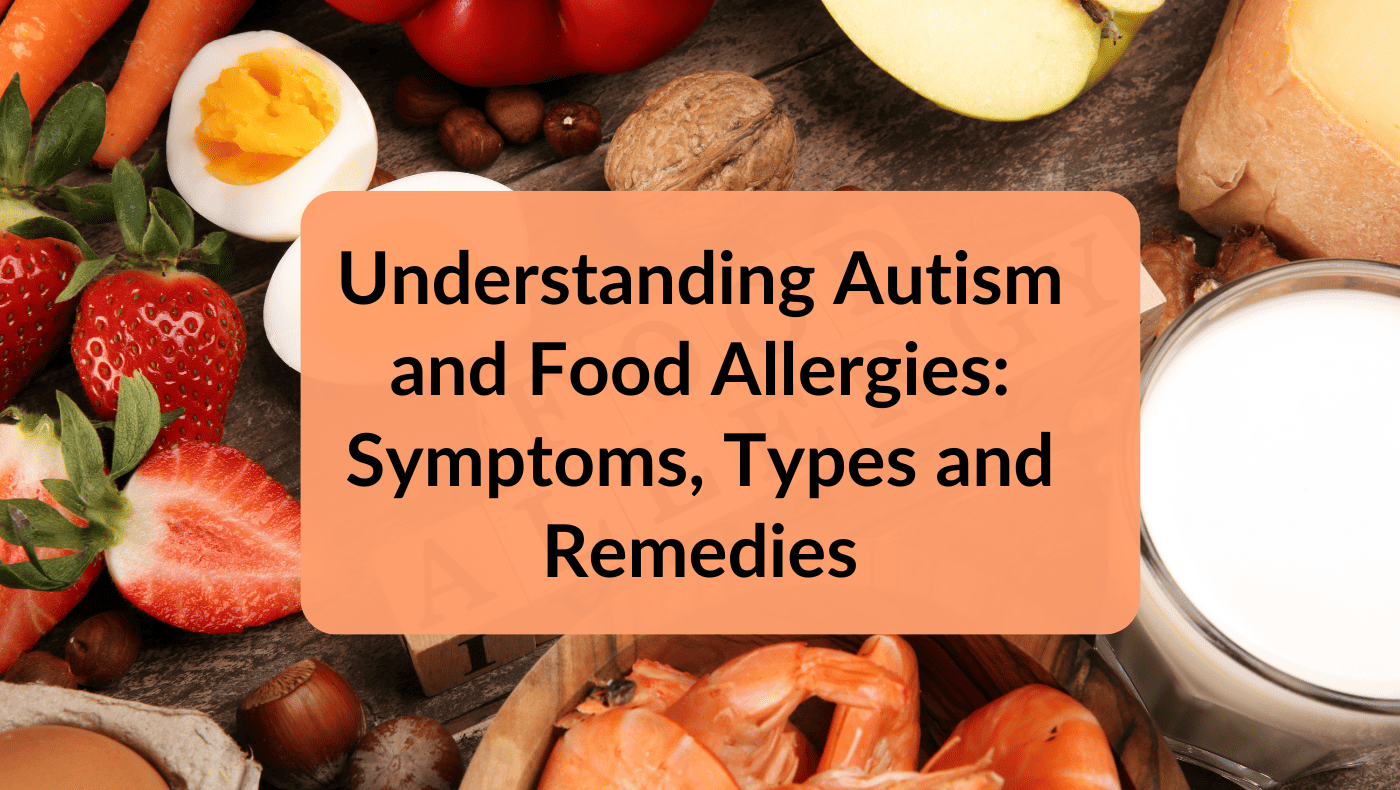Last updated on March 13th, 2025 at 07:00 am
In today’s world, the health challenges Autism and Food Allergies pose are more prominent than ever.
Autism and food allergies can share a few symptoms, which can sometimes be challenging.
For instance, issues with communication, behavior, and digestion can be related to both food allergies and autism, making it hard to understand.
Understanding food allergies is therefore crucial as you try to provide the safest diet for your child.
In this blog post, I will look at what food allergies are, their symptoms, and the most common types, and provide some home remedies you can use to manage them.
What is a Food Allergy?
A food allergy occurs when your immune system reacts to a particular food, thinking it’s harmful.
Common symptoms of a food allergy include rashes, hives, swelling, and difficulty swallowing.
In some cases, severe allergic reactions, such as anaphylaxis, might need immediate medical attention as they can be life-threatening.
Digestive distress is a common symptom of food allergies and can be especially prevalent in children with autism.
Upon consumption of an allergen, the body perceives it as a threat and reacts defensively, leading to an allergic response.
This reaction manifests in the digestive system, resulting in symptoms such as nausea, vomiting, abdominal pain, diarrhea, or constipation.
This discomfort can exacerbate behavioral issues in children with autism, making it critical to identify and manage food allergies effectively.
Signs and Symptoms of Food Allergies
The symptoms of food allergies can vary depending on the severity and type of allergy.
They can occur within minutes to hours of consuming the allergenic food.
Some of the typical symptoms include:
- Skin reactions, such as hives, rashes, and swelling
- Digestive problems, such as diarrhea, vomiting, and abdominal pain
- Respiratory issues, such as sneezing, wheezing, and shortness of breath
- Anaphylaxis – a severe life-threatening reaction characterized by difficulty breathing, swelling, low blood pressure, and loss of consciousness
In the early stages, food allergies in children can be somewhat subtle and may not immediately cause concern.
You might notice unusual responses after your child eats specific foods.
Initial signs could include a mild rash, slight swelling around the mouth or eyes, and unexplained fussiness or irritability during or after meals.
More severe and immediate indications could include extensive skin reactions, severe vomiting, or respiratory distress.
If the child has autism, changes in behavior, or increased gastrointestinal discomfort after meals, could also be indicative of a potential food allergy.
It’s vital for you to pay close attention to these early signs and seek advice from a healthcare provider if they suspect a food allergy.
Types of Food Allergies
There are many types of food allergies, but some are more common than others.
Some of the more common food allergies include:
- Egg allergy
- Peanut allergy
- Tree nut allergy
- Gluten allergy
- Dairy allergy
- Shellfish allergy
- Soy allergy
- Corn allergy
In conclusion, while the list above includes the most common food allergies, it is by no means exhaustive.
The prevalence of food allergies among children is increasing, and hence, a wider variety of foods are now being recognized as potential allergens.
It is vital to remain vigilant and adaptable to the possibility that your child could develop an allergy to food not typically associated with allergic reactions.
Testing for Food Allergies
If you suspect your child has a food allergy, it’s crucial to seek medical advice. A healthcare provider may recommend several tests to diagnose food allergies accurately.
- Skin Prick Test: This involves placing a tiny amount of the suspected allergen on the skin, and then pricking the area lightly. If a raised red bump, often accompanied by itching, appears after 15-20 minutes, it could be indicative of an allergy to that specific food.
- Blood Test: A blood test can measure the amount of IgE antibodies in the body. The immune system produces these antibodies in response to allergens. A higher IgE level corresponds to a greater food allergy likelihood.
- Elimination Diet: This involves removing the suspected allergen from your child’s diet for a couple of weeks. If symptoms improve, the food is reintroduced. A return of symptoms might suggest a potential allergy.
- Oral Food Challenge: This is a controlled, supervised test where small amounts of the suspected allergen are consumed by the patient while under medical supervision. It’s usually performed in a clinic or hospital setting due to the risk of a potentially severe reaction.
In summary, you play an essential role in identifying and managing food allergies in your child, particularly in autism. If you suspect your child may have a food allergy, it’s crucial to seek professional medical advice. Healthcare providers can perform various tests to confirm if your child has a food allergy. Remember, you are not alone in this journey.
Autism and Food Issues
Children with autism may also experience food-related issues.
These may include food selectivity, which involves being very selective with what they eat, oral motor difficulties, and digestive issues.
It’s also common for some children with autism to crave specific types of foods that aren’t necessarily healthy, resulting in imbalanced nutrition.
Indeed, studies have found that children with autism are more often diagnosed with food allergies.
According to a research study published in the journal JAMA Network Open, children with autism are significantly more likely to have food, respiratory, and skin allergies.
The study found that nearly 11.25% of children reportedly diagnosed with Autism Spectrum Disorder (ASD) have a food allergy, notably higher than the nearly 4.25% of children who are not diagnosed with ASD.
This suggests a noteworthy link between autism and food allergies, though more research is necessary to understand the exact reasons for this connection.
These findings underscore the importance of further studying the relationship between ASD and allergies, as the correlation could provide crucial insights into possible shared factors contributing to the development or exacerbation of both conditions.
Home Remedies for Food Allergies
There are several home remedies that you can use to manage food allergies.
Although they may not eliminate the allergic reaction entirely, they can significantly minimize their severity. Some of the effective home remedies include:
Healing Leaky Gut – Leaky gut syndrome is a digestive condition where bacteria and toxins can leak through the intestinal wall. This can lead to a range of health problems, including food allergies. Healing the leaky gut can be a practical approach to managing food allergies.
Quercetin-Rich Foods – foods such as apples, onions, and berries contain Quercetin, a natural antihistamine that helps reduce the severity of allergic reactions.
Honey and Local Pollen – Honey and local pollen contain small amounts of the allergen, which can help reduce allergic reactions when consumed regularly.
Probiotic Foods – Probiotics help support the immune system and maintain gut health, mitigating the risk of food intolerances.
Turmeric and Ginger – these potent anti-inflammatory herbs can help reduce inflammation and allergic reactions in the body.
Peppermint and Chamomile Tea -These natural remedies help soothe digestive issues associated with food allergies, promoting overall wellness.
In conclusion, food allergies can be life-threatening, and it’s essential to understand the symptoms, types, and the right approach to managing them, especially if your child has autism.
To provide the best care for your child, always consult your physician when you suspect a food allergy and maintain a healthy diet by avoiding certain foods and incorporating home remedies.
Remember, educating yourself about food allergies and autism is the first step toward ensuring your child’s safety and happiness.
If you are a parent of a child on the autism spectrum and looking for support, you may check my nutritional guides for free.
It will provide you with a range of strategies and interventions that can help you support your child’s development alongside their medical treatment.
Additional Resource:
- Check Out My Resources
- Autism Detox: 10 Natural Detox for Kids
- Picky Eating and Autism
- Thinking Outside the Box Alternative Approaches to Children with Autism





0 Comments